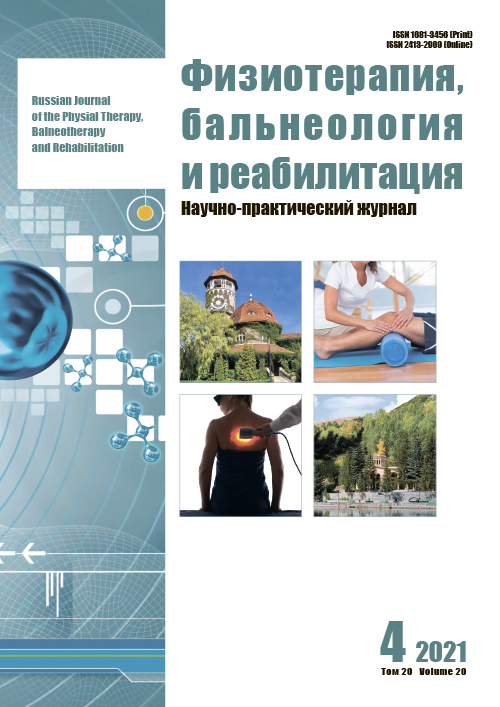Применение подвесных систем с жёсткими эластичными элементами в физической реабилитации пациентов с ампутационными дефектами нижних конечностей
- Авторы: Болотов Д.Д.1,2, Стариков С.М.3, Захарова Я.Н.1
-
Учреждения:
- Федеральное бюро медико-социальной экспертизы
- Российская медицинская академия непрерывного профессионального образования
- Медицинский институт непрерывного образования Московского государственного университета пищевых производств
- Выпуск: Том 20, № 4 (2021)
- Страницы: 315-323
- Раздел: Оригинальные исследования
- Статья опубликована: 15.07.2021
- URL: https://rjpbr.com/1681-3456/article/view/107370
- DOI: https://doi.org/10.17816/rjpbr107370
- ID: 107370
Цитировать
Полный текст
Аннотация
Обоснование. Физические упражнения на подвесных системах (гравитационная нейромышечная активация) являются высокоэффективным средством физической реабилитации пациентов с различными патологиями. Модернизация таких изделий за счёт применения жёстких эластичных строп или оснащение стандартных тренажёров эластичными элементами расширяет возможности данного вида оборудования, позволяет осваивать новые виды упражнений, положительно влияя на силу, тонус и выносливость мышечных групп.
Цель исследования ― изучить влияние подвесных систем с жёсткими эластичными элементами (стропами), включённых в программы физической реабилитации, на координацию движений и выносливость при ходьбе пациентов с ампутационными культями на уровне бедра.
Материал и методы. Проведено тестирование 12 пациентов в возрасте от 44 до 53 лет до и после повторного протезирования в условиях клиники Федерального бюро медико-социальной экспертизы. Активная часть курса физической реабилитации с включением подвесных систем с эластичными элементами составляла менее двух недель. Ставя перед пациентом в отдалённом периоде задачу повышения скорости передвижения на протезе, в ближайшем периоде мы ориентировались исключительно на правильность структуры шага и его субъективные ощущения.
Результаты. Техническое усовершенствование подвесных систем за счёт эластичных элементов повышает удобство их применения, темпы освоения и степень эффективности, определяя высокий процент достижения запланированного результата. Включение в курс занятий на тренажёре эластичных строп позволяет пациенту осваивать и уверенно совершать различные сложнокоординированные движения, включая приседания, участвовать в новых видах игровой деятельности, что способствует повышению его адаптации и социализации в обществе. Субъективно пациенты отмечают бόльшую силу мышечных групп, прошедших дополнительную нагрузку на данных системах, улучшение координации движений и выносливости при ходьбе на протезе в целом, а также чувство «правильности» ходьбы, что подтверждается методами клинического обследования и результатами биомеханических тестов (повышение темпа и скорости ходьбы при снижении длительности цикла шага).
Заключение. Подвесные системы максимально полезны для профилактики и устранения атрофии мышц, обеспечивающих движения тазового пояса, в сравнении с обычными динамическими тренировками и ходьбой на протезе. Модификации подвесных систем за счёт включения в них эластичных элементов позволяет проводить функциональные тренировки не только с использованием статических, но и динамических упражнений, расширяя возможности их применения в медицинской и комплексной реабилитации, адаптивной физической культуре и адаптивном спорте.
Полный текст
Об авторах
Денис Дмитриевич Болотов
Федеральное бюро медико-социальной экспертизы; Российская медицинская академия непрерывного профессионального образования
Автор, ответственный за переписку.
Email: bolotov_d@mail.ru
ORCID iD: 0000-0003-1320-0960
SPIN-код: 8846-6802
к.м.н., доцент
Россия, Москва; МоскваСергей Михайлович Стариков
Медицинский институт непрерывного образования Московского государственного университета пищевых производств
Email: bolotov_d@mail.ru
ORCID iD: 0000-0003-4915-6164
к.м.н., доцент
Россия, МоскваЯна Николаевна Захарова
Федеральное бюро медико-социальной экспертизы
Email: bolotov_d@mail.ru
ORCID iD: 0000-0003-3345-0828
Россия, Москва
Список литературы
- Валериус К.П., Колстер Б.К., Франк А. Мышцы. Анатомия. Движения. Тестирование / пер. с англ. под ред. М.Б. Цикунова. Москва: Практическая медицина, 2015. 432 с.
- Майерс Т.В. Анатомические поезда. Churchill Levingstone, 2018. 272 c.
- Янда В. Функциональная диагностика мышц. Москва: Эксмо, 2010. 352 с.
- Kirkesola G. Neurac: a new treatment method for chronic musculoskeletal pain // Fysiotherapeuten. 2009. Vol. 76, N 12. Р. 16–25.
- Liu H., Yao K., Zhang J., et al. Sling exercise therapy for chronic low-back pain (Protocol) // The Cochrane Library. 2013. Vol. 9. CD010689. doi: 10.1002/14651858.CD010689
- Eom M.Y., Chung S.H., Ko T.S. Effects of bridging exercise on different support surfaces on the transverse abdominis // J Physical Therapy Science. 2013. Vol. 25. N 10. Р. 1343–1346. doi: 10.1589/jpts.25.1343
- Huang J.S., Pietrosimone B.P., Ingersoll C.D., et al. Sling exercise and traditional warmup have similar effects on the velocity and accuracy of throwing // J Strength Conditioning Res. 2011. Vol. 25, N 6. Р. 1673–1679. doi: 10.1519/JSC.0b013e3181da7845
- Kim J.H., Kim Y.E., Bae S.H., Kim K.Y. The effect of the neurac sling exercise on postural balance adjustment and muscular response patterns in chronic low back pain patients // J Physical Therapy Sci. 2013. Vol. 25, N 8. Р. 1015–1019. doi: 10.1589/jpts.25.1015
- Kuszewski M., Gnat R., Saulicz М. Stability training of the lumbopelvohip complex influence stiffness of the hamstrings: a preliminary study // Scand J Med Sci Sports. 2009. Vol. 19, N 2. Р. 2606. doi: 10.1111/j.1600-0838.2008.00793.x
- Kline J.B., Krauss J.R., Maher S.F., Qu X. Core strength training using a combination of home exercises and a dynamic sling system for the management of low back pain in preprofessional ballet dancers // J Dance Med Sci. 2013. Vol. 17, N 1. Р. 2433. doi: 10.12678/1089-313x.17.1.24
- Saeterbakken A.H., van Den Tillaar R., Seiler S. Effect of core stability training on throwing velocity in female handball players // J Strength Conditioning Res. 2011. Vol. 25, N 3. Р. 712–718. doi: 10.1519/JSC.0b013e3181cc227e
- Pedersen J.I., Magnussen R., Kuffel E., Seiler S. Sling exercise training improves balance, kicking velocity and torso stabilization strength in elite soccer players // Medicine Science Sports Exercise. 2006. Vol. 38, N 5. Р. 243. doi: 10.1249/00005768-200605001-01072
- Лига Приедена. Слинг-терапия для лечения болей // Больничная газета. Информативное издание ООО «Лиепаяс регионала слимница». 2013. № 42. С. 2.
- Истомин А.Г., Луценко Е.В. Модифицирование спортивных подвесных систем для использования в реабилитационном процессе // Травма. 2016. Т. 17, № 2. С. 6–10.
- Солодянин Е.Е., Бурмистров А.Л., Бондарева Е.А., Мозоль В.В. Нейромышечная активация с применением подвесных систем в реабилитации пациентов // Медицинские новости. 2014. № 11. С. 53–55.
- Витензон А.С. Закономерности нормальной и патологической ходьбы человека. Москва: Зеркало-М, 1998. 271 с.
- Витензон А.С., Иванов А.М., Гриценко Г.П., Петрушанская К.А. Реабилитация инвалидов с культей бедра посредством программируемой электростимуляции мышц при ходьбе. Москва: Зеркало-М, 2001. 176 с.
Дополнительные файлы









